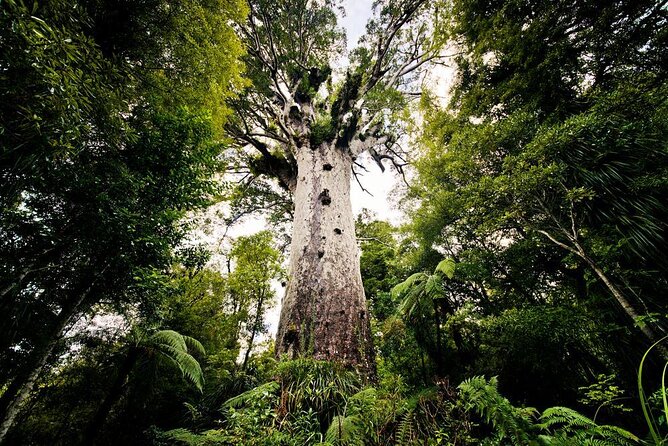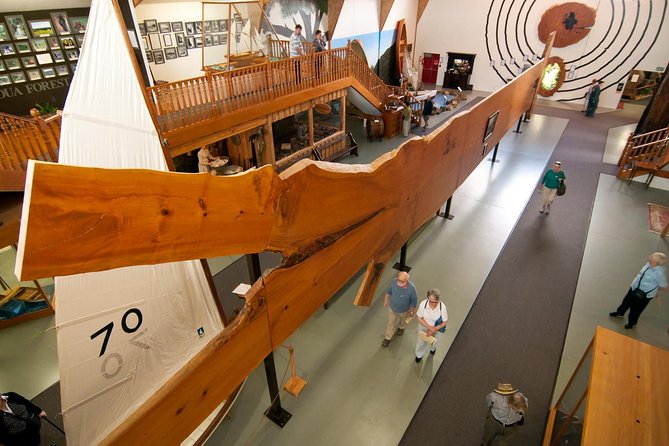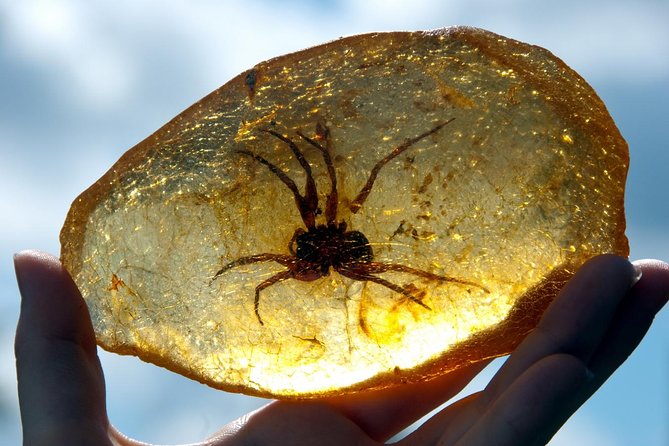The Kauri tree, New Zealand’s oldest living resident, stands as a testament to nature’s resilience, with some individuals boasting ages that surpass 2,000 years. These majestic giants, cherished by the Māori, play a vital role in the ecosystem, providing habitats for diverse wildlife. Historically, their timber and gum have shaped construction and artistry in the region. However, the survival of these ancient trees faces significant challenges today, prompting urgent conservation efforts. What does the future hold for these iconic sentinels of New Zealand’s landscape?
Key Points

- Kauri trees are among the oldest living trees in New Zealand, with some estimated to be over 2,500 years old.
- They hold significant ecological and cultural importance, providing habitats for wildlife and being integral to Māori heritage.
- Kauri wood was traditionally used by Māori for carving and construction, deeply intertwining their culture with the tree.
- Extensive logging in the 19th century threatened kauri forests, prompting conservation efforts to protect these ancient giants.
- Current conservation initiatives focus on combating threats like climate change and kauri dieback disease to ensure their survival for future generations.
Significance of Kauri Trees

Kauri trees hold immense ecological and cultural significance in New Zealand, serving as a vital resource for both the environment and the Māori people.
These majestic giants provide essential habitats for various wildlife, contributing to the overall biodiversity of the region. Their timber, known for its durability and resistance to decay, has historically been used in construction and carving, reflecting the deep connection between the Māori culture and these trees.
Plus, kauri gum has been a valuable commodity, used in everything from jewelry to varnishes.
However, ongoing threats such as disease and deforestation underscore the importance of conservation efforts. Protecting kauri trees is crucial not just for their survival, but also for the cultural heritage and ecological health of New Zealand.
You can also read our reviews of more tours and experiences in North Island.
Historical Context of Kauri
The rich history of kauri trees reflects their longstanding relationship with New Zealand’s landscape and its people, particularly the Māori, who’ve revered these giants for centuries.
Kauri wood, prized for its durability and beauty, played a vital role in Māori culture, used in carving, construction, and tools.
Early European settlers recognized kauri’s value, leading to extensive logging that significantly impacted the forests.
By the late 19th century, conservation efforts began as awareness grew about the ecological importance of these trees.
Today, kauri forests serve not only as a reminder of history but also as crucial ecosystems.
Efforts to protect and restore these ancient trees highlight the ongoing commitment to preserving New Zealand’s unique natural heritage for future generations.
The Kauri Museum Experience

Visitors can dive into the fascinating world of kauri trees at the Kauri Museum, where immersive exhibits and hands-on experiences bring their history and significance to life.
The museum showcases a remarkable collection of ancient kauri artifacts, including lignites and swamp kauri, some of which are tens of thousands of years old. Guests can engage with interactive displays, handle authentic kauri samples, and explore the ecological and economic impact of these majestic trees.
Guided storytelling at various stations enriches the experience, offering deep insights into kauri’s cultural relevance. The museum fosters a sense of connection and appreciation for New Zealand’s natural heritage, making it a must-visit for anyone interested in the remarkable story of the kauri tree.
Guided Tour Highlights
Setting out on a guided tour at the Kauri Museum reveals a captivating exploration of the majestic kauri trees and their profound impact on New Zealand’s history and culture.
Visitors gain unique insights as they journey through the museum, uncovering the stories and significance of these ancient giants.
Highlights of the tour include:
-
Engaging interactions with kauri samples and artifacts.
-
Fascinating stories shared by knowledgeable guides at various stations.
-
The chance to examine ancient lignites and swamp kauri up close.
-
A small group setting, ensuring personalized attention and a richer experience.
This immersive experience not only deepens appreciation for kauri trees but also connects visitors to New Zealand’s rich natural heritage.
Accessibility and Inclusivity
Kauri Museum prioritizes accessibility and inclusivity, ensuring that everyone can enjoy its rich offerings regardless of mobility challenges.
The museum features wheelchair-accessible pathways, allowing easy navigation through exhibits and displays. Visitors with mobility impairments can fully engage with the museum’s treasures without feeling restricted.
Plus, the small group tours accommodate various needs, making it easier for families and individuals to participate together. Children must be accompanied by an adult, promoting a safe and inclusive environment for younger visitors.
Visitor Reviews and Insights
With an impressive overall rating of 4.5 stars on platforms like Viator and Tripadvisor, the Kauri Museum has garnered positive feedback from those who’ve experienced its unique offerings. Visitors appreciate the museum’s engaging atmosphere and informative displays, providing a deeper understanding of the kauri tree’s significance.
Knowledgeable guides share captivating stories about kauri history.
Interactive exhibits allow hands-on experiences with kauri samples.
The small group size fosters a personalized tour experience.
Access to ancient kauri artifacts enriches the learning journey.
Despite some concerns about booking issues through Viator, most reviews reflect a memorable visit, highlighting the museum as a must-see destination for anyone interested in New Zealand’s natural heritage.
Conservation Efforts for Kauri
The Kauri Museum not only highlights the cultural and historical significance of kauri trees but also emphasizes the urgent conservation efforts aimed at protecting these iconic giants from various threats.
In recent years, kauri trees have faced challenges such as climate change, invasive species, and the deadly kauri dieback disease. To combat these issues, local communities and organizations are collaborating on research and restoration initiatives.
Public awareness campaigns educate visitors on the importance of hygiene protocols to prevent disease spread. Plus, funding supports scientific studies and conservation projects tailored to safeguard kauri forests.
Future of Kauri Trees
Ensuring the future of these majestic trees hinges on a combination of robust conservation efforts, community engagement, and ongoing scientific research. Organizations and local communities are uniting to combat the threats facing kauri trees, particularly from kauri dieback disease.
To protect these ancient giants, several strategic actions are being implemented:
-
Monitoring and Research: Scientists study disease transmission and develop treatments.
-
Public Awareness Campaigns: Educational programs inform visitors about hygiene practices to prevent disease spread.
-
Restoration Projects: Communities are involved in planting new kauri seedlings and restoring habitats.
-
Collaborative Policies: Government and non-profits work together to create effective conservation policies.
Frequently Asked Questions
How Long Do Kauri Trees Typically Live?
Kauri trees typically live for over 1,000 years, with some specimens reaching ages of up to 2,500 years. Their longevity makes them remarkable giants of the forest, contributing significantly to New Zealand’s natural heritage and ecosystem.
What Types of Animals Inhabit Kauri Forests?
Kauri forests host diverse wildlife, including native birds like the kererū and tui, as well as reptiles such as skinks and geckos. These ecosystems thrive, providing habitats that support various species within New Zealand’s unique biodiversity.
Can I Purchase Kauri Wood Products at the Museum?
Visitors can’t purchase kauri wood products at the museum. However, they can explore various exhibits and learn about the significance of kauri wood, its history, and conservation efforts during their engaging tour experience.
Are There Any Myths Associated With Kauri Trees?
Kauri trees inspire various myths, particularly among Māori culture. They’re often seen as sacred, with legends highlighting their connection to the ancestors, nature, and the spirit world, emphasizing the trees’ importance in the cultural heritage.
How Can I Help in Kauri Conservation Efforts?
To aid in kauri conservation, you can volunteer at local initiatives, contribute to funding projects, avoid spreading diseases, and educate others about the importance of preserving these majestic trees for future generations.
Sum Up
The Kauri tree stands as a testament to New Zealand’s natural heritage and resilience.
Its deep-rooted significance, rich history, and the stories shared at The Kauri Museum inspire both awe and respect.
As conservation efforts ramp up, there’s hope that future generations will witness these majestic giants thrive.
By fostering awareness and appreciation, everyone can play a part in protecting these ancient trees, ensuring they continue to flourish in New Zealand’s unique ecological landscape.
More Tour Reviews in North Island
Not for you? Here's more nearby things to do in North Island we have reviewed
- 14 Best Tours In North Island
- 3 Best Shopping Tours In North Island
- 10 Best Private Drivers In North Island
- 4 Best Fishing Tours In North Island
- 2 Best Workshops And Classes In North Island
- 2 Best 2 Day Tours In North Island
- 2 Best Private Tours In North Island
- Full-Day Rainforest Getaway in Northland
- Private Charter 8 Hour Snorkel and Paddleboard the Poor Knights – 1 to 12 People
- Fine Wine Tour in Napier, New Zealand
- Private Airport Shuttle – Matamata-Piako District To/From Auckland Airport
- Private Cooking Class With Chef of the Year in Hawke’S Bay at Your Residence
